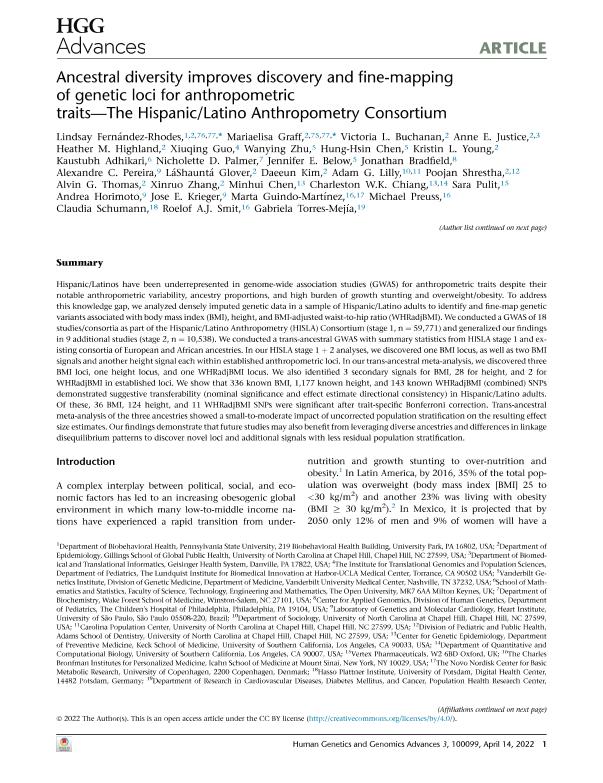Artículo
Ancestral diversity improves discovery and fine-mapping of genetic loci for anthropometric traits—The Hispanic/Latino Anthropometry Consortium
Fernández Rhodes, Lindsay; Graff, Mariaelisa; Buchanan, Victoria L.; Justice, Anne E.; Highland, Heather M.; Guo, Xiuqing; Zhu, Wanying; Chen, Hung-Hsin; Young, Kristin L.; Adhikari, Kaustubh; Palmer, Nicholette D.; Below, Jennifer E.; Bradfield, Jonathan; Pereira, Alexandre C.; Glover, LáShauntá; Kim, Daeeun; Lilly, Adam G.; Shrestha, Poojan; Thomas, Alvin G.; Zhang, Xinruo; Chen, Minhui; Chiang, Charleston W.K.; Pulit, Sara; Horimoto, Andrea; Krieger, Jose E.; Guindo-Martínez, Marta; Preuss, Michael; Schumann, Claudia; Smit, Roelof A.J.; Torres Mejía, Gabriela; Gonzalez-Jose, Rolando

Fecha de publicación:
04/2022
Editorial:
Cell Press
Revista:
Human Genetics and Genomics Advances
e-ISSN:
2666-2477
Idioma:
Inglés
Tipo de recurso:
Artículo publicado
Clasificación temática:
Resumen
Hispanic/Latinos have been underrepresented in genome-wide association studies (GWAS) for anthropometric traits despite their notable anthropometric variability, ancestry proportions, and high burden of growth stunting and overweight/obesity. To address this knowledge gap, we analyzed densely imputed genetic data in a sample of Hispanic/Latino adults to identify and fine-map genetic variants associated with body mass index (BMI), height, and BMI-adjusted waist-to-hip ratio (WHRadjBMI). We conducted a GWAS of 18 studies/consortia as part of the Hispanic/Latino Anthropometry (HISLA) Consortium (stage 1, n = 59,771) and generalized our findings in 9 additional studies (stage 2, n = 10,538). We conducted a trans-ancestral GWAS with summary statistics from HISLA stage 1 and existing consortia of European and African ancestries. In our HISLA stage 1 + 2 analyses, we discovered one BMI locus, as well as two BMI signals and another height signal each within established anthropometric loci. In our trans-ancestral meta-analysis, we discovered three BMI loci, one height locus, and one WHRadjBMI locus. We also identified 3 secondary signals for BMI, 28 for height, and 2 for WHRadjBMI in established loci. We show that 336 known BMI, 1,177 known height, and 143 known WHRadjBMI (combined) SNPs demonstrated suggestive transferability (nominal significance and effect estimate directional consistency) in Hispanic/Latino adults. Of these, 36 BMI, 124 height, and 11 WHRadjBMI SNPs were significant after trait-specific Bonferroni correction. Trans-ancestral meta-analysis of the three ancestries showed a small-to-moderate impact of uncorrected population stratification on the resulting effect size estimates. Our findings demonstrate that future studies may also benefit from leveraging diverse ancestries and differences in linkage disequilibrium patterns to discover novel loci and additional signals with less residual population stratification.
Archivos asociados
Licencia
Identificadores
Colecciones
Articulos(IPCSH)
Articulos de INSTITUTO PATAGONICO DE CIENCIAS SOCIALES Y HUMANAS
Articulos de INSTITUTO PATAGONICO DE CIENCIAS SOCIALES Y HUMANAS
Articulos(SEDE CENTRAL)
Articulos de SEDE CENTRAL
Articulos de SEDE CENTRAL
Citación
Fernández Rhodes, Lindsay; Graff, Mariaelisa; Buchanan, Victoria L.; Justice, Anne E.; Highland, Heather M.; et al.; Ancestral diversity improves discovery and fine-mapping of genetic loci for anthropometric traits—The Hispanic/Latino Anthropometry Consortium; Cell Press; Human Genetics and Genomics Advances; 3; 2; 4-2022; 1-21
Compartir
Altmétricas



